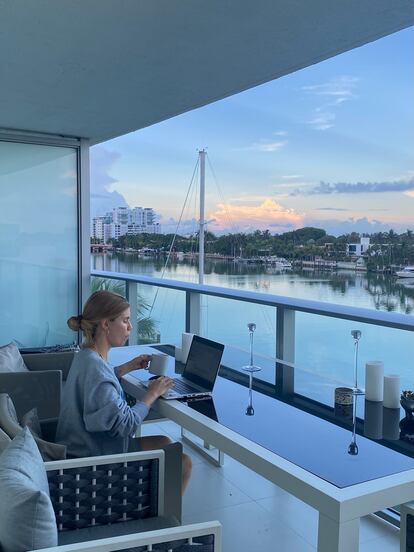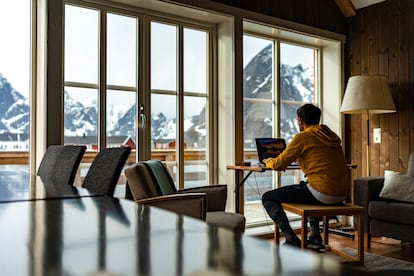Digital nomads embrace their unique way of life
6 min readOn May 5, the World Health Organization (WHO) formally announced the end of the Covid-19 pandemic. But over these three-plus years, several pandemic-born habits have become ingrained in our daily lives. Masks may be gone, but remote work has firmly established itself, surpassing the pre-Covid era. Along with this shift, a lifestyle trend closely tied to our tech-driven world has gained traction: digital nomadism.
The term “digital nomad” was coined in 1997 by scientist Tsugio Makimoto and journalist David Manners in a book of the same name. However, it was during the pandemic that its use became more widespread. In 2020, many workers realized that working remotely didn’t necessarily mean working from home. Three years later, many digital nomads are still enjoying a unique lifestyle that has its own set of challenges. “Being a digital nomad and working 100% remotely isn’t for everyone — it can get a bit lonely at times,” says Verónica Robredo, a young woman who began to combine travel and work during the pandemic. For this tech worker, what began during the pandemic has become a way of life she plans to continue for the rest of her career.
Pablo Vázquez stumbled upon this way of life somewhat unexpectedly. In March 2020, he was working in Manila (Philippines) for an international organization. When the pandemic hit, his company offered him the choice to either stay there and work from home or return to Spain. Now he works remotely six months out of the year and seizes the opportunity to travel the world with his laptop in hand. Carla Varela had a similar experience when she was let go in June 2020. In hindsight, she sees getting laid off as lucky. It propelled her into something that may not have happened otherwise. “When I got fired, I decided to go the self-employed route. It never even crossed my mind to go back to an office job. I’ve been offered a bunch of jobs, but I turned them all down. I guess I’m just part of this generation that wants to live life on our own terms, you know? Having the freedom to do what I want is way more important than having a high-paying job working for someone else.”
Tranquil rural corners, big cities and beaches
The Nomad List website offers up-to-date information about the most popular destinations among digital nomads, and Portugal, Japan and Thailand are usually at the top of the list. In Spain, the top choices are Madrid, Barcelona and the Canary Islands. Spain, with its tourist appeal, was slow to embrace its potential as a nomadic destination. But that changed when the new Startup Law was introduced in December 2022. Like Germany, Croatia, and Greece, Spain now offers a one-year visa specifically for foreign nationals working remotely in Spain. So, where do all these digital nomads come from? According to Statista, the United States has the highest number of offshore workers, followed by the United Kingdom. Spain is 10th, behind the Netherlands and ahead of India.
While the idealized image of digital nomadism portrays remote workers typing away on their laptops while enjoying picturesque beach views, tranquil rural destinations are becoming more popular. Before exploring far-flung places like Japan, Macau, Taiwan, Latvia and Estonia, Pablo Vázquez embarked on his nomadic journey from a rural area just a few miles from his hometown. “My first stop was this little town outside Madrid, pretty far from everything, but surprisingly close to the place I was born and raised.” Verónica Robredo went to several small Portuguese towns to find her surf-and-work paradise. “I’ve been to two towns in the Algarve — one really tiny and another more famous spot, Lagos, near Sagres. Also, I’ve spent some time in Vila Nova de Milfontes.” One special characteristic of digital nomads, apart from carrying their offices with them, is that they prefer longer stays than traditional vacationers. “I usually stay at least three months,” says Robredo, who has also spent time in Miami.

Work schedules and taxes
Working remotely can become problematic when there is a big time difference between the office and work site. Attorney Carla Varela ran into this issue during one of her trips. “I was in Australia in January and there was a huge 10-hour time difference. I know, it sounds crazy, but it worked out pretty well because I could explore and work at the same time. Mornings were all mine, and it was so relaxing!” Since 2020, she has travelled to countries like Mexico, Uruguay, Chile, Bolivia, and Argentina, filling her passport with visa stamps. She went alone to Argentina but usually travels with a group of fellow nomads.
Juan Fernández-Estrada, co-founder of the Blue Banana clothing brand, has been working remotely for a few months in Australia and Indonesia. He successfully established a smooth work routine to stay connected with his team, even though they are located thousands of miles apart. “I’m actually doing a great job at doing it all! The time change has been a game-changer for me, allowing me to have a routine and lifestyle that’s completely different from what I had in Madrid. I wake up early to work, hit the beach for some surfing, and then from 5pm-10pm, I do meetings with Spain,” says the 26-year-old businessman. His vision exemplifies the shift in mindset within fledgling companies. “At Blue Banana, we’ve had these video conferences where we all connected from different corners of the world. One person joined after surfing, another after skiing, and the rest were either at the office or at home.” However, while they value remote working, they also place great emphasis on being present. “We believe that physically working alongside colleagues and mentors has great benefits that complement remote work,” says Fernández-Estrada.

Beyond coordinating work schedules, Pablo Vázquez says there is a “financial obstacle” that can complicate nomadic life: choosing where to pay income taxes. “It’s something that I think we’re all still figuring out,” he says. Spaniards working abroad who wish to file their income tax returns in Spain must have spent a minimum of 183 days in the country to meet the tax residency requirement.
“A privileged lifestyle”
There are various ways to travel, but being a long-term digital nomad can be expensive. That’s why Verónica Robredo says it’s a privileged lifestyle. “Being able to live this lifestyle with all the comforts of home — your house, belongings, routine — can easily multiply expenses by a factor of four or five,” she says. Robredo rents her home in Madrid to cover housing expenses in the different places she visits, since “short-term rentals are more expensive.” Pablo Vásquez agrees. “Being a digital nomad is often associated with having a high income. However, it can be pricey. Anyone who disagrees is probably just a backpacker with a laptop! In many places, if you want to live comfortably, it’ll cost you.”

Not all jobs are suitable for remote work, and many employers that could allow it are ordering employees to return to the office. According to Spain’s National Statistics Institute (INE), as of November 2022, remote work is practiced by 14% of the employed population. This is a significant increase compared to the pre-pandemic period when it was at 4.8% in 2019, but it has been gradually declining since March 2020.
Currently, approximately 35 million individuals worldwide have made the deliberate choice to transition from traditional offices to remote workspaces. According to Nomad List, this shift is composed of 53% men and 47% women, predominantly in their thirties, with university educations and working in technology and creative fields. All it takes is a computer and an internet connection — the rest is up to you and how you want to embrace the nomadic life.
Sign up for our weekly newsletter to get more English-language news coverage from EL PAÍS USA Edition



